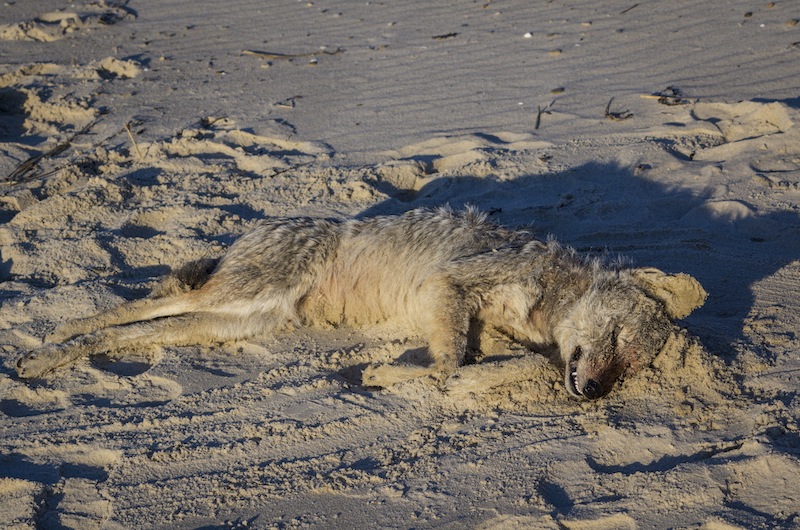The Vineyard has had its second confirmed sighting of a live Eastern coyote — the first sighting in at least three years — Island wildlife biologist Gus Ben David 2nd said Wednesday.
Unlike the Island’s previous live sighting and five earlier dead coyote sightings, this one did not occur on the Island’s north shore.
Although Mr. Ben David would not disclose the location of the animal to protect the confidentiality of the property owners, he confirmed the coyote was photographed and filmed on a camcorder at approximately midnight Tuesday.
“No doubt about it,” Mr. Ben David told the Gazette on Wednesday. He said the coyote was a fully grown adult of average size. “Looked like 40 pounds. It wasn’t an exceptionally big one, but definitely an adult,” Mr. Ben David said.
Coyotes are found on the Elizabeth islands and Cape Cod, but there are none on the Vineyard beyond an isolated sighting of a single animal three years ago and a handful of carcasses found washed up on the shoreline over the years.
Mr. Ben David believes the animal came from Naushon, the largest of the Elizabeth islands which has had an established Eastern coyote population for decades. He said environmental factors can force the notoriously territorial animals to seek new terrain. Occasionally that means by water.
“They swim, they are known to do that,” Mr. Ben David said. “They do it when they are expanding their range in their particular area, or if the prime habitat is taken over by alpha animals. They can get pushed out of their territory, and then they would swim across.”
Because Naushon is only four miles northwest of Martha’s Vineyard, all the previous coyote sightings have occurred on or near the Island’s north shore, where passage is possible although difficult in strong currents. But this animal was spotted elsewhere, Mr. Ben David said, prompting further questions surrounding its whereabouts.
“This animal most likely came from Naushon,” Mr. Ben David said. “That means it has already traversed part of the Island, which they do. They are tremendous travelers until they set up their territory and find a den site. This animal could be in Edgartown tonight and West Tisbury tomorrow.”
Eastern coyotes evolved from their smaller Western counterparts, moving across the continent and cross-breeding with wolves along the way.
Mr. Ben David said there is no chance that the wild coyote was brought to the Island by a human. “No, no way. Coyotes, even if you raise one from a little pup, they’re vicious. No way that animal was brought to this Island. That animal basically got here on its own volition,” he said.
Mr. Ben David said he has contacted a state environmental official to report the coyote sighting. While coyotes, which look like “racy dogs,” according to Mr. Ben David, can vary widely in coloring, he said this one was fairly average in both weight and appearance.
“It wasn’t anything exceptional color-wise,” Mr. Ben David said. “The typical grayish with the black. Normal.”
Although Mr. Ben David said the previous live coyote was never spotted again and likely killed by hunters, he believes that having a breeding population of coyotes on the Island, where there are no natural predators for the animals, would have serious ecological ramifications. For example, Naushon used to have about 150 domestic and 300 wild sheep, Mr. Ben David said. Now there are 12 domestic sheep. And they have to be kept inside at night.
With its recent resurgence of small farming, the Vineyard has large populations of sheep, goats and free-range chickens. The Island also has a large domestic pet population.
“If they get established here, you’re going to have human-animal conflicts,” Mr. Ben David said. “They’re a predator, they affect everything. They would cause a lot of problems, especially for people with livestock,” he added.
“There’s an abundance of prey here,” he continued. “Rabbit carcass. Whale carcass. Seal carcass. Berries, seeds, nuts, mice, snakes, anything. They’ll basically consume just about anything.”
While Mr. Ben David said some environmentalists would suggest leaving the animal alone because it most likely arrived on the Island by natural means, he said it’s widely accepted in the hunting and outdoorsmen community to shoot coyotes if they’re spotted, especially considering the threat they pose to farmers.
Mr. Ben David said now that the one coyote has been spotted, he and other Island biologists will take steps to ascertain if there are more. He said if someone is certain they’ve spotted a coyote, they should call him.
“I haven’t had a coyote call in I would dare say at least two years, and it’s the second time we’ve had a live one. We’ll see what happens,” Mr. Ben David said. “They’re amazing creatures. They’re the most adaptable. Wily, wily coyote — that’s apropos.”






Comments (35)
Comments
Comment policy »